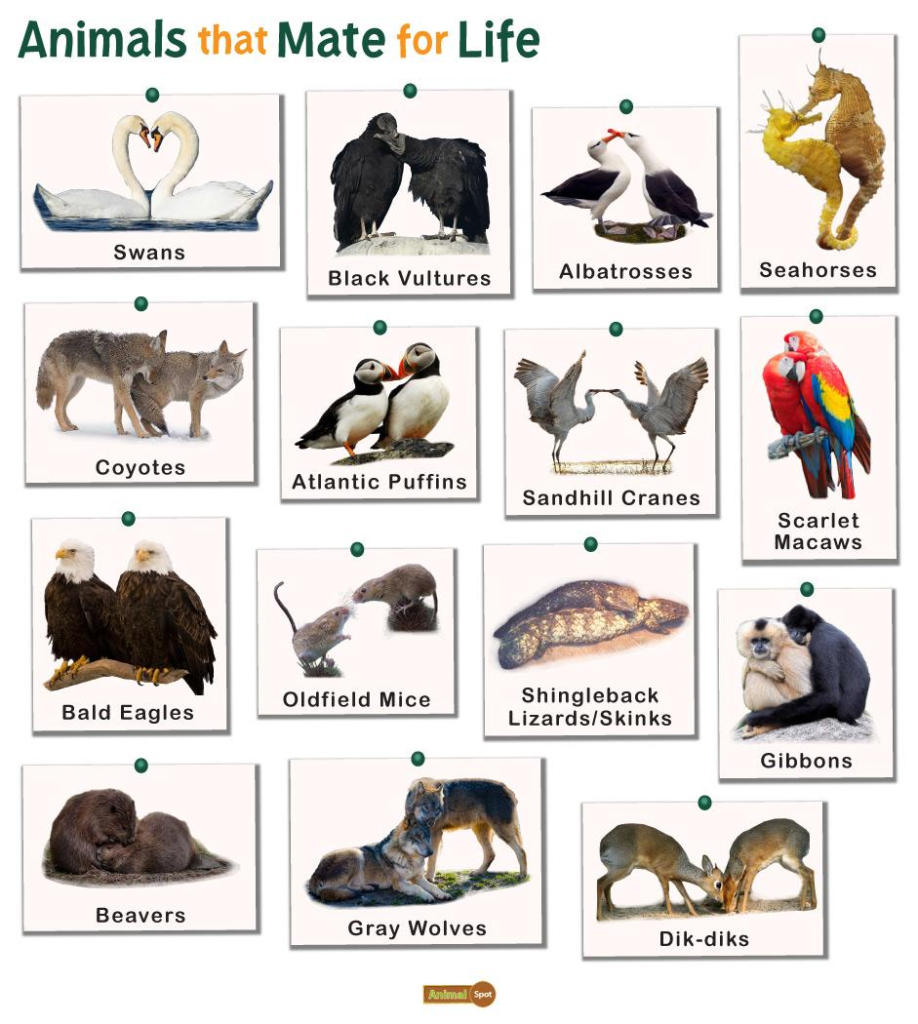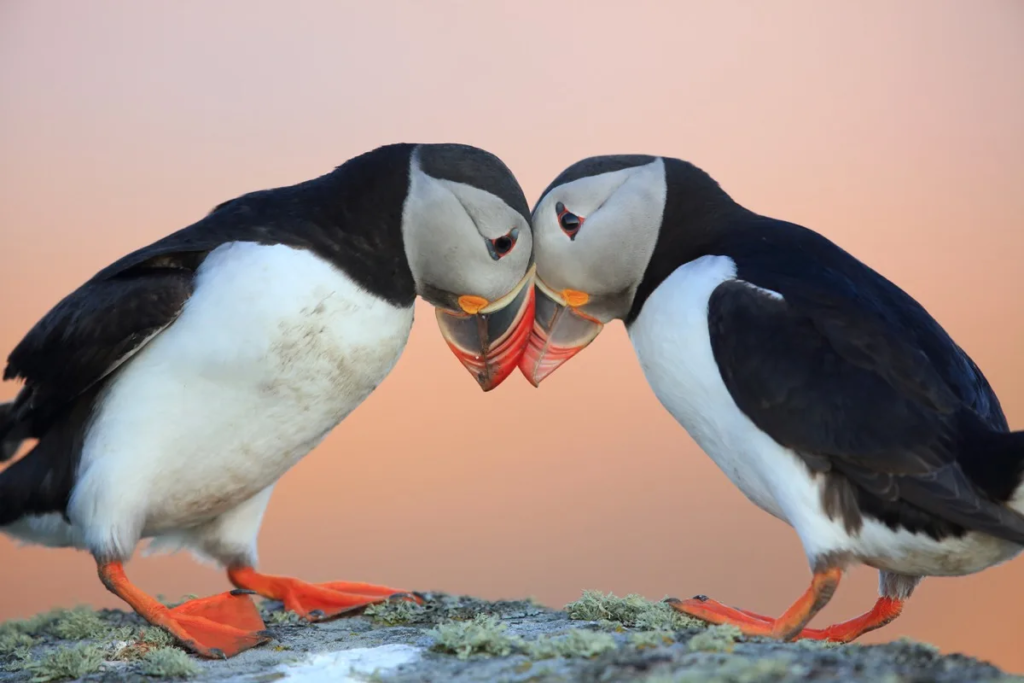Key Takeaways:
- Several animal species are known to form long-term monogamous bonds and mate for life. These include various birds, mammals, and fish.
- Some examples of animals that mate for life include albatrosses, bald eagles, beavers, coyotes, gibbons, gray wolves, macaroni penguins, puffins, sandhill cranes, and seahorses.
- Though these animals often form lifelong pair bonds, there can still be variability within the species – some individuals may engage in extra-pair copulations or change mates over time.
- Evolutionary biologists have proposed various explanations for lifelong monogamy in animals, such as biparental care of offspring, mate guarding, and resource defense.
- Monogamous mating systems offer benefits like shared parenting duties, but can also constrain reproductive opportunities for one or both partners.

What is Monogamy and Why Do Some Animals Mate for Life?
Monogamy refers to a mating system where one male and one female form an exclusive mating pair. This lifelong partnership is relatively rare in the animal kingdom, exhibited by only around 3% to 5% of mammalian species. However, monogamy is more prevalent among birds, occurring among around 90% of bird species.
Several evolutionary hypotheses may explain the development of lifelong monogamy as a mating strategy:
Biparental Care – In species where both parents are necessary to successfully raise offspring, monogamy ensures the male contributes. For example, male and female wolves work together to hunt, feed, and protect their pups.
Mate Guarding – Males may remain monogamous to prevent females from mating with competitors. Guarding a single mate also reduces the energy spent seeking additional mates.
Resource Defense – Males and females may form lifelong bonds to cooperatively defend critical resources like food, shelter, and nesting sites.
Overall, lifelong monogamy seems to arise when the reproductive benefits of having a consistent, invested parenting partner outweigh the costs of missed mating opportunities. However, monogamous pairs still face tradeoffs between shared parental duties and constrained reproduction. Next, we’ll explore some key examples of animals that mate for life.
What are Some Animals That Mate for Life?
Here we highlight several animal species known to form monogamous lifelong pair bonds:
Birds That Mate for Life
Albatrosses – These large seabirds mate for life. Partners work together to raise a single chick, taking turns incubating the egg and foraging at sea.
Bald Eagles – Bald eagle pairs rebuild massive nests each breeding season and may stay together for over a decade. Both parents feed and guard the fledglings.
Eurasian Beavers – Beavers form monogamous family units sharing den sites. Lifelong partners cooperate to maintain territories and lodges.
Gibbons – Gibbon couples duet together to reinforce lifelong bonds. As apes, they also provide intensive biparental care of offspring.
Macaroni Penguins – Mate pairs return to the same nesting site annually. They take turns hunting and warming the eggs with an abdominal pouch.
Puffins – Atlantic puffins court with elaborate beak gestures and form long-term bonds. Partners work together to incubate a single egg clutch.

Sandhill Cranes – Sandhill cranes perform elaborate dances to form pair bonds that can last their entire lifespans of up to 20 years.
Scarlet Macaws – Vibrantly colored scarlet macaws remain with one partner, mutually grooming and feeding each other.

Swans – Most swans bond for life, though around 20% “divorce” and re-pair. Partners work together to guard territory and raise cygnets.

Mammals That Mate for Life
Beavers – As mentioned, beavers live in monogamous family units and work cooperatively with bonded partners.
Coyotes – Coyotes typically mate for life. Both parents protect and bring food back to their pups.
Dik-Diks – These tiny antelopes form monogamous pairs that last until one partner dies. Males defend mates from other male challengers.
Gray Wolves – Wolf pairs breed once annually and collaborate to raise litters of pups. Both parents regurgitate food for hungry cubs.
Seahorses – Seahorses perform elaborate courtship rituals before forming permanent monogamous bonds. Males even gestate fertilized eggs.
Other Monogamous Species
French Angelfish – These vivid reef fish bond for life in monogamous pairs. Partners work together to defend their shared territory from intruders.
Termites – Termite kings and queens form lifelong partnerships. They cooperate to build the colony and produce all offspring.
Lovebirds – As their name suggests, lovebirds form close social bonds and lifelong mates. They constantly groom and feed each other.
Peruvian Opossums – These opossums bond with a single partner and jointly care for offspring. Males even lactate and carry babies in a pouch.
Oldfield Mice – Oldfield mice pair up with one partner until death. Females raise pups together in communal nests.
Emperor Penguins – Emperor penguins form loyal bonds for a single breeding season to incubate eggs and shelter chicks.
Is Monogamy Always for Life?
While the above animals often form lifelong partnerships, monogamy is still quite rare – most mating systems are either polygynous with one male mating multiply or promiscuous with both sexes mating frequently.
Even within “monogamous” species, there is flexibility and variation between individuals. Some may engage in:
- Extra-pair copulations (EPCs) – Mating with individuals besides the primary partner, seen in up to 25% of bird pairs
- Breeding outside pairs – In colonies, mating with an available partner if a mate dies
- Serial monogamy – Forming sequential monogamous bonds after a previous mate dies
- Divorce – Dissolving a pair bond to find a new mate, seen in 1-3% of bird couples annually
So while lifelong monogamy is the dominant strategy for certain animals, it does not mean mating for life is absolute. There are always individuals exhibiting more varied bonding and reproduction strategies.
What are the Benefits of Mating for Life?
Forming lifelong pair bonds offers several key benefits for monogamous animal species:
- Co-parenting – Partners can share duties like nest-building, guarding, and feeding offspring
- Mate guarding – Ensures paternity certainty and prevents competition for mates
- Resource control – Pairs can better defend territories, dens, or nesting sites
- Support – Long-term bonds allow partners to develop rapport and help each other
However, there are also potential costs of monogamy:
- Missed opportunities – Partners cannot mate with others, limiting reproductive success
- Genetic diversity – Offspring may have higher homozygosity due to a single mating pair
- Constraint – One partner may be much more invested, almost coercing their mate to retain the pair bond
Overall though, lifelong monogamy seems to increase reproductive fitness for species that require heavy mutual parental investment like birds rearing chicks or mammals with dependent young.
Examples of Scientific Research on Animal Monogamy
Here are some examples of scientific studies providing evidence into monogamous behaviors and mating for life in animals:
- Researchers used genetic analysis of 80 sandhill crane chicks, finding 87.5% were sired by the female’s long-term partner, indicating highly monogamous mating [1].
- A 2020 study on albatrosses found divorce is exceptionally rare, with no evidence of extra-pair paternity in over 200 chicks [2].
- Coyotes in urban areas were found to be more monogamous, likely because concentrated resources reduce territoriality and make defending a mate easier [3].
- Only 3% of wolf breeding pairs dissolved in a study of 385 wolves over 13 years. Most formed new bonds only after a partner died [4].
- Among 17 Gibbon groups studied, there were no cases of cheating and all infants were offspring of the resident male, evidence of strict monogamy [5].
Summary
In summary, while the majority of animals have polygamous or promiscuous mating systems, a small percentage of species do form monogamous lifelong bonds. Examples include various birds, mammals, and fish that mate for life like albatrosses, beavers, gibbons, gray wolves and seahorses.
These animals often provide biparental care and share reproductive duties with one partner. But even within “monogamous” species, some flexibility exists – not every individual mates exclusively for life. Still, lifelong pair bonding offers key benefits that seem to outweigh the costs for these monogamous species.
References:
[1] Jones KL, et al. High levels of extra-pair paternity in an isolated, low-density, island population of sandhill cranes (Grus canadensis). Behaviour. 2010 Apr;147(4):451-72.
[2] Young LC, et al. Low levels of extra-pair paternity in Laysan albatrosses. Journal of Heredity. 2020 Jan 1;111(1):67-74.
[3] Geffen E, et al. Mate selection, regulation of reproductive competition, and geographic variability in the mating system of coyotes. Behavioral Ecology. 2011 Sep 8;22(6):1290-300.
[4] vonHoldt BM, et al. The genealogy and genetic viability of reintroduced Yellowstone grey wolves. Molecular Ecology. 2008 Jan;17(1):252-74.
[5] Reichard UH, Boesch C. Monogamy: Mating strategies and partnerships in birds, humans and other mammals. Cambridge University Press; 2003 Mar 24
- Where Is Ecoden Dreams Located?
- How to Change Light Mode on a Fantech Keyboard?
- What Are the Symptoms of Omicron?
- What Is Shear Plane Definition?
- Why Are My Lips So Dry?
- Why Is My Eero Blinking White?
- Is Relativism Ever Really True?
- can you play mario kart on xbox?
- How can I see if someone has taken a screenshot of my VSCO?
- How To Replace Ford F250 Side Mirrors?
- How to Program Verizon Fios One Remote?
- Why Is My Dog’s Balls Peeling?
- How to Find Out If Husband Has Secret Facebook Account?
- Which Likert Scale Is Best?
- Are Rockwood Trailers 4 Season?